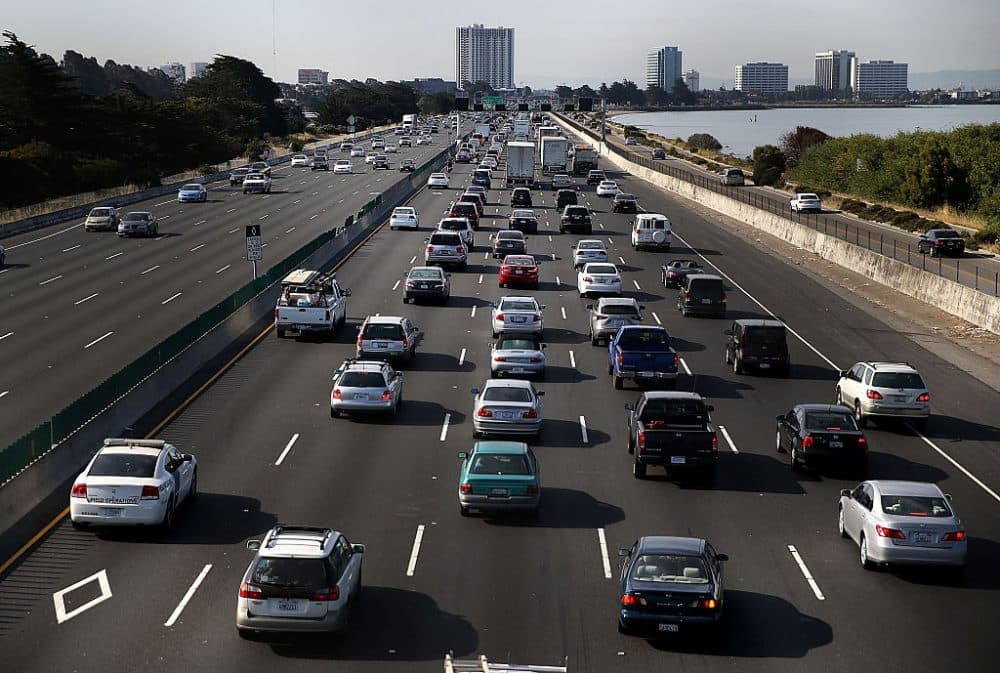Advertisement
At 60, America's Interstate Highway System Is Showing Signs Of Age

Sixty years ago today, President Dwight D. Eisenhower signed the Federal Highway Act of 1956. It marked the birth of the interstate highway system, now a 47,000-mile network designed to ease crowded, crumbling roads in post-war America.
At the time, it was sold as one of the most ambitious public works projects ever, but six decades later, many interstates are overcrowded and under maintained. Here & Now's Jeremy Hobson speaks with William Wilkins of The Road Information Program.
Interview Highlights: William Wilkins
On the original vision for the interstate system in the 1950s
"Perhaps it started when then-Lieutenant Dwight D. Eisenhower went on a convoy trip from Washington D.C. to San Francisco in 1919. And that trip took 62 days. And I just looked on MapQuest yesterday to see what it would take to drive today, and that's about 45 hours. So he provided strong support for building it so that it would improve traffic safety, reduce travel times and improve the nation's economic productivity.
President Eisenhower also saw what the Autobahn did for Germany in World War II. And so, when he signed that legislation in 1956, it was actually called the Dwight D. Eisenhower National System of Interstate and Defense Highways, so that it would also play a defensive role for us if there were any attack on the United States."
On whether interstate planners expected so much growth in vehicle ownership
"I don't think so. The world has changed quite a bit since that vision in 1956. And our population has increased from 91 percent from roughly 168 million to 321 million today so it's kind of hard to be able to project that kind of growth."
On the status of maintenance funding for the interstate highways
"The current backlog of needed improvements is roughly $189 billion. Fifty-nine billion is needed to improve pavement conditions, $30 billion to improve bridges and another $100 billion for needed system expansion. And a lot of it is to the fact that the motor fuel tax is not keeping up with the needed repairs. It was last raised in 1983, and it's 18.4 cents. When the Interstate Act was passed, it was a three-cent gas tax increase, and if you would have indexed that for inflation, that would be about 26 cents today, so we're not even letting our motor fuel tax keep up with needed repairs."
On why it seems like there are more tolls on the East Coast than other parts of the country
"Los Angeles was famous for coining the phrase ‘freeway.’ Here in the East Coast, some of the highways that went into the interstate system were already toll roads, like the Pennsylvania Turnpike, the New York Thorough way. I think you're going to see more tolling in the future with the gas tax not being raised because that's one way to improve the system, and I think you'll find that many of the toll roads are actually in better shape because they're raising enough money to make the needed repairs and improvements."
On the outlook for putting more highways underground
"That is probably an ideal way to go. But right now we're not spending enough to maintain the system we have so until there's some form of motor fuels tax or some other sustainable form of funding for the federal highway trust fund, I think we're going to have a very difficult time just maintaining the system as it is today."
Guest
William Wilkins, executive director of The National Road Information Program (TRIP), a transportation research group. The organization tweets @TRIP_Inc.
This segment aired on June 29, 2016.